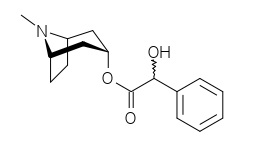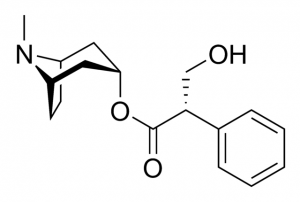Poison-tipped arrows. Royal assassinations. European witchcraft. Ritual suicide. Throughout humanity’s history, the aptly named Deadly Nightshade, also known scientifically as Atropa belladonna, has had a reputation as a natural killer. The name “Atropa” in Atropa belladonna derives from the Greek Goddess Atropos, one of the three sisters of Fate. The sisters three manage the thread of life of all things living; one sister spins the thread, one measures the thread, and Atropos, the third sister, is the cutter of the life thread, representing death. [M.R. Lee 2007]
|
Plant Classification |
|
| Common Name: | Deadly Nightshade |
| Family: | Solanaceae |
| Genus: | Atropa |
| Species: | Atropa belladonna |
You’ve probably heard of Deadly Nightshade at least once, even if you’ve never seen it before. Atropa belladonna is a perennial herbaceous plant, native to Europe, which can be most easily identified by it’s sleek, jet-black berries. The berries of belladonna can be likened to blueberries in size and shape, but the biggest differences can be found at the chemical level. Atropa belladonna is host to a highly toxic group of chemical compounds known as tropane alkaloids, which can be found not just in belladonna’s signature fruit, but concentrated throughout the entire plant, from leaf to root. Belladonna’s berries start off green, but as the the fruit ripens, the tropane alkaloids develop, turning them black.

By Rüdiger Kratz via Wikimedia Commons
These toxic tropane alkaloids are named atropine, scopolamine, and hyoscyamine, and are most prevalent in the roots of belladonna. [F. Ashtiania and F. Sefidkonb 2011] Ingestion of too many of these compounds can induce paralysis, dilated pupils, rapid heart rate, constipation, and severe, unpredictable hallucinations, which made it a favorite of those involved in witchcraft. But before even that, dating back to the Greeks, belladonna was an active ingredient in Bacchus’s wine. Devotees of the cult of Dionysius partook of Bacchus’s wine for the purpose of of wild, wanton copulation. Considering the ever-present sinful nature of belladonna, could any good come from the study of such a plant?

Chemical structure of an atropine molecule.

Chemical structure of an scopolamine molecule.

Chemical structure of an hyoscyamine molecule.
In French, there is a saying: “Il faut souffrir pour etre belle,” which roughly translates to “one must suffer to be beautiful.” This is exemplified in renaissance Italy, wherein extracts of belladonna were frequently prepared for use as a cosmetic. A drop of the extract in each eye was used to induce aforementioned pupil dilation, which simulated arousal, thus, enhancing the user’s beauty. The name “belladonna” in Atropa belladonna is Italian for “beautiful woman.”[Holzman 1998] Unfortunately, beauty must be suffered for, and extensive use of belladonna as a cosmetic would lead to blurred vision, increased heart rate, and, ultimately, blindness.
However, belladonna’s mark on history is not entirely a sinister one. Ironically, despite being poisonous, belladonna has a long history of medicinal use, and has a wide range of potential applications. Atropine, a tropane alkaloid present in the roots, stem, leaves, and seeds of belladonna, has been used as an anesthetic since the first century.[F. Ashtiania and F. Sefidkonb 2011] Today, atropine is used against spasms during gallbladder attacks, as an antidote for poisoning from certain insecticides, and as a pre-medication before surgery, to reduce salivation. The tropane alkaloid scopolamine, located in the stem, leaf, and seeds of belladonna, staves off vertigo, motion sickness, and nausea, in the form of a worn patch.[Springob and Kutchan 2009] Finally, the tropane alkaloid hyoscyamine provides relief to various gastrointestinal disorders, such as irritable bowel syndrome, pancreatitis, and peptic ulcers. Due to it’s similarities to the previous tropane alkaloids, some researchers also believe that it may possess similar anesthetic properties.
References:
Ashtiania F. and Sefidkonb F. 2011. Tropane alkaloids of Atropa belladonna L. and Atropa acuminata royle ex Miers plants. Journal of Medicinal Plants Research 5(29), 515-6522.
Berdai MA, Labib S, Chetouani K, Harandou M. 2012. Atropa belladonna Intoxication: A Case Report. Pan Afr Med J[Internet]. 11:72. Available from: https://www.ncbi.nlm.nih.gov/pmc/articles/PMC3361210/
Holzman R. 1998. The Legacy of Atropos, the Fate Who Cut the Thread of Life[Internet]. [cited 6 Mar 2017]; Anesthesiology 7 1998, 89: p. 241-249. Available from: http://anesthesiology.pubs.asahq.org/article.aspx?articleid=1947026
Kennedy DO. 2013. The Deliriants-The Nightshade (Solanaceae) Family. Plants and the Human Brain. Oxford (UK): Oxford University Press. p. 125-137.
Lee M.R. 2007. Solanaceae IV: Atropa belladonna, Deadly Nightshade [Internet]. [cited 6 Mar 2017]; J R Coll Physicians Edinb 2007, 37: p. 77-84. Available from: http://www.rcpe.ac.uk/journal/issue/journal_37_1/R-lee.pdf
Springob and Kutchan 2009. Introduction to the Different Classes of Natural Products. In: Anne E. Osbourn, Virginia Lanzotti, editors. Plant-derived Natural Products: Synthesis, Function, and Application. New York (NY), Springer-Verlag. p. 3-50.
Wink, M. 1998. Alkaloidal Plants and Fungi Playing and Important Role in the History of Mankind. In: Roberts M, editor. Alkaloids: Biochemistry, Ecology, and Medicinal Applications. New York (NY): Springer US. p. 11-44.


2 Pingbacks